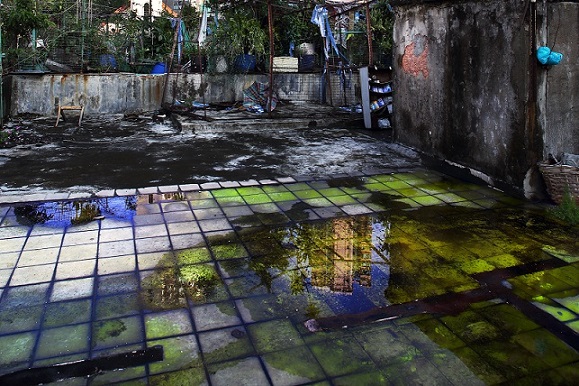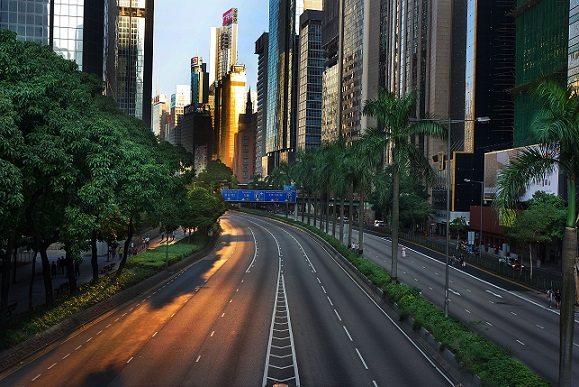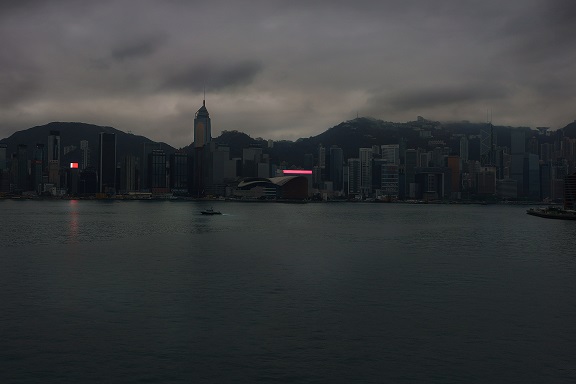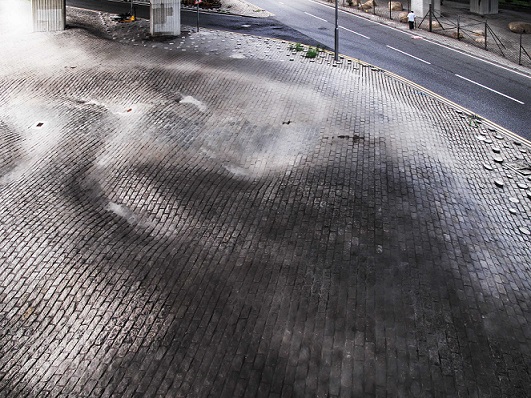新/另類藝術空間
- 光影作坊Alfred Ko’s ‘Pond on the roof’
楊陽 (Yang YEUNG)
at 5:59pm on 25th May 2015




Captions:
1. Alfred Ko, Pond on the roof.
2. Alfred Ko, October on Gloucester.
3. Alfred Ko, Red before dawn.
4. Alfred Ko, The slope.
Photos courtesy of the artist
(原文以英文發表,評論「不/離:高志強攝影作品選」。)
There is something natural about Pond on the roof (2013) that stands out from other color photographs in his recent solo ‘a/part: early and recent works of Alfred Ko Chi-keung’. Pond on the roof comes about on a regular day of the artist’s wandering around the city. Ko found this small puddle of water gathered on a greyish rooftop in Shek Kip Mei. The puddle is of an undefined shape with no beginning and no end, no introduction and no conclusion. It reflects patches of green, blue and yellow and a vague shape of a high-rise from somewhere out in the city. The water is still, but presents the imagination of its morphing into something else as the camera looks away. Instead of taking fabricated urban spaces and mass produced excess of consumer products as his object of gaze in the color series Claustrophobia and Agoraphobia, Pond on the roof concerns itself with the beauty of transience.
The unintentional, unknown and unnamed traces of the human in the photograph, and their beauty, remind me of Jacob Kirkegaard’s AION (2006). AION is a video and sound installation of abandoned interior spaces in the exclusion area near the Chernobyl nuclear power plant site. The zone was declared contaminated, hence evacuated since the accident in 1986. Without camera movement, the image seems still, but a closer look shows dust or debris and peeling wall paper making the tiniest tremble. Sound-wise, one hears layers of each room’s resonant frequencies. This is made by the artist placing recording equipment in each room, recording for ten minutes, then playing back the recording in the room while re-recording it. In this gesture that pays tribute to Alvin Lucier’s seminal work from the 1960s “I am sitting in a room” that attempts to employ the sound of his voice to give shape to a room, Kirkegaard renders the enclosure and its breach audible. Sound settles into the process of decay in a busy kind of solitude, framing the way we see (water in the pool, the broken piano, peeling walls, picture frames, etc.).
Ko and Kirkegaard’s works are worlds apart in time, and in geographical, cultural, and historical contexts, but they are similarly committed to addressing the actual and potential violence of the humanly devised. They are specific forms of engagement that reveal the obscenity of the accumulation of power by illegitimate means. At the same time, they are both actively pursuing beauty.
Another photograph in a/part also stands out. October on Gloucester (2014) was made on a certain day cleared of teargas, one of those days still wrestling with memories of the recent past. Others on the footbridge over Gloucester Road must have shared the serendipitous encounter with the setting sun that brushed broad strokes across long stretches of asphalt all the way down and up to a distant building. Not only is sunlight rare in Ko’s photography, but also the way it finds equanimity in the ordinary, made possible only by the extraordinary struggles by the people to change the pulse of the city, to free the roads of traffic. In both Pond on the Roof and October on Gloucester, the artist engages what he is personally subjected to – at once the precariousness of the public realm and the beauty of home.
Ko had a different relationship with beauty when he first explored with color after a four-decade-long practice in black and white photography. The early explorations show a collection of strange colors and incongruous objects in urban non-places. The relatively confrontational approach is essential for the artist to show the vulgarity of the gigantic, flaunting its strength against the weak. To show the hollowness of this loudness is to claim the power to bring the gigantic up close for negotiation.
Now, beauty is possible not because of a hunting-driven gaze made in a decisive moment, but rather, because of a shift of attention – in Ko’s words, to return to "zone five – the neutrality of the density of middle grey." Thus, the title image red before dawn of a/part – the beauty of the grey Victoria Habor, the morning yet to come, yet to be devoured by the self-conscious glory of the money-powered. Grey is the state of pausing in between extremes; this is the goal.
What is the value of seeing beauty in injury and destruction (a question many artists have always asked, but perhaps more consciously, intensely and frequently since the multiple global movements against illegitimate powers)? I find inspiration from Elaine Scarry’s idea that beauty calls for justice rather than being separate from it. In her book On Beauty and Being Just (1999) and related lectures, Scarry says that the moment we see beautiful things, we are in the state of bliss, and that very moment makes us marginal or secondary; we are "happy to be in a supporting rather than a central role." This moment of "unselfing" makes us happy. As the recognition of beauty confers aliveness to the object of beauty, it also obliges us to protect this beauty.
On the night of the exhibition opening, photographer Roy Lee (Ko’s long-time friend) also shared where he found justice at work. "These are concrete images," he said, "that give an interpretation, in a society where interpretation itself is not encouraged." It is only after he affirmed the ground for the act of interpretation itself as a moral undertaking before he addressed the object of interpretation, in its multitude. He sees the undertaking as showing the inadequacy to be among a group of people to feel at ease and at peace with, for acts of interpretation by the artist demands a different kind of yearning for truth.
Ko repeatedly uses the word "absurdity" to describe what he sees in reality. I would propose that he also personalizes this absurdity in his photographic reality, without clairvoyance, without pride, without haste, to make possible suspension of time as much as the appreciation of timeliness. He does so by not looking away and not giving up on the possibility of beauty out of the most absurd. "If the world were clear, art would not exist." ("Absurd Creation, Philosophy and Fiction" in Albert Camus’ The Myth of Sisyphus)
Life has a way of returning to normal – cars racing to connect one financial district to the next. But processes of normalization can never totalize life, for aliveness has nothing to do with normality; it is a matter of beauty.
First published in issue 114 (May 2015) of AM Post, Hong Kong.
1. Alfred Ko, Pond on the roof.
2. Alfred Ko, October on Gloucester.
3. Alfred Ko, Red before dawn.
4. Alfred Ko, The slope.
Photos courtesy of the artist
(原文以英文發表,評論「不/離:高志強攝影作品選」。)
There is something natural about Pond on the roof (2013) that stands out from other color photographs in his recent solo ‘a/part: early and recent works of Alfred Ko Chi-keung’. Pond on the roof comes about on a regular day of the artist’s wandering around the city. Ko found this small puddle of water gathered on a greyish rooftop in Shek Kip Mei. The puddle is of an undefined shape with no beginning and no end, no introduction and no conclusion. It reflects patches of green, blue and yellow and a vague shape of a high-rise from somewhere out in the city. The water is still, but presents the imagination of its morphing into something else as the camera looks away. Instead of taking fabricated urban spaces and mass produced excess of consumer products as his object of gaze in the color series Claustrophobia and Agoraphobia, Pond on the roof concerns itself with the beauty of transience.
The unintentional, unknown and unnamed traces of the human in the photograph, and their beauty, remind me of Jacob Kirkegaard’s AION (2006). AION is a video and sound installation of abandoned interior spaces in the exclusion area near the Chernobyl nuclear power plant site. The zone was declared contaminated, hence evacuated since the accident in 1986. Without camera movement, the image seems still, but a closer look shows dust or debris and peeling wall paper making the tiniest tremble. Sound-wise, one hears layers of each room’s resonant frequencies. This is made by the artist placing recording equipment in each room, recording for ten minutes, then playing back the recording in the room while re-recording it. In this gesture that pays tribute to Alvin Lucier’s seminal work from the 1960s “I am sitting in a room” that attempts to employ the sound of his voice to give shape to a room, Kirkegaard renders the enclosure and its breach audible. Sound settles into the process of decay in a busy kind of solitude, framing the way we see (water in the pool, the broken piano, peeling walls, picture frames, etc.).
Ko and Kirkegaard’s works are worlds apart in time, and in geographical, cultural, and historical contexts, but they are similarly committed to addressing the actual and potential violence of the humanly devised. They are specific forms of engagement that reveal the obscenity of the accumulation of power by illegitimate means. At the same time, they are both actively pursuing beauty.
Another photograph in a/part also stands out. October on Gloucester (2014) was made on a certain day cleared of teargas, one of those days still wrestling with memories of the recent past. Others on the footbridge over Gloucester Road must have shared the serendipitous encounter with the setting sun that brushed broad strokes across long stretches of asphalt all the way down and up to a distant building. Not only is sunlight rare in Ko’s photography, but also the way it finds equanimity in the ordinary, made possible only by the extraordinary struggles by the people to change the pulse of the city, to free the roads of traffic. In both Pond on the Roof and October on Gloucester, the artist engages what he is personally subjected to – at once the precariousness of the public realm and the beauty of home.
Ko had a different relationship with beauty when he first explored with color after a four-decade-long practice in black and white photography. The early explorations show a collection of strange colors and incongruous objects in urban non-places. The relatively confrontational approach is essential for the artist to show the vulgarity of the gigantic, flaunting its strength against the weak. To show the hollowness of this loudness is to claim the power to bring the gigantic up close for negotiation.
Now, beauty is possible not because of a hunting-driven gaze made in a decisive moment, but rather, because of a shift of attention – in Ko’s words, to return to "zone five – the neutrality of the density of middle grey." Thus, the title image red before dawn of a/part – the beauty of the grey Victoria Habor, the morning yet to come, yet to be devoured by the self-conscious glory of the money-powered. Grey is the state of pausing in between extremes; this is the goal.
What is the value of seeing beauty in injury and destruction (a question many artists have always asked, but perhaps more consciously, intensely and frequently since the multiple global movements against illegitimate powers)? I find inspiration from Elaine Scarry’s idea that beauty calls for justice rather than being separate from it. In her book On Beauty and Being Just (1999) and related lectures, Scarry says that the moment we see beautiful things, we are in the state of bliss, and that very moment makes us marginal or secondary; we are "happy to be in a supporting rather than a central role." This moment of "unselfing" makes us happy. As the recognition of beauty confers aliveness to the object of beauty, it also obliges us to protect this beauty.
On the night of the exhibition opening, photographer Roy Lee (Ko’s long-time friend) also shared where he found justice at work. "These are concrete images," he said, "that give an interpretation, in a society where interpretation itself is not encouraged." It is only after he affirmed the ground for the act of interpretation itself as a moral undertaking before he addressed the object of interpretation, in its multitude. He sees the undertaking as showing the inadequacy to be among a group of people to feel at ease and at peace with, for acts of interpretation by the artist demands a different kind of yearning for truth.
Ko repeatedly uses the word "absurdity" to describe what he sees in reality. I would propose that he also personalizes this absurdity in his photographic reality, without clairvoyance, without pride, without haste, to make possible suspension of time as much as the appreciation of timeliness. He does so by not looking away and not giving up on the possibility of beauty out of the most absurd. "If the world were clear, art would not exist." ("Absurd Creation, Philosophy and Fiction" in Albert Camus’ The Myth of Sisyphus)
Life has a way of returning to normal – cars racing to connect one financial district to the next. But processes of normalization can never totalize life, for aliveness has nothing to do with normality; it is a matter of beauty.
First published in issue 114 (May 2015) of AM Post, Hong Kong.
